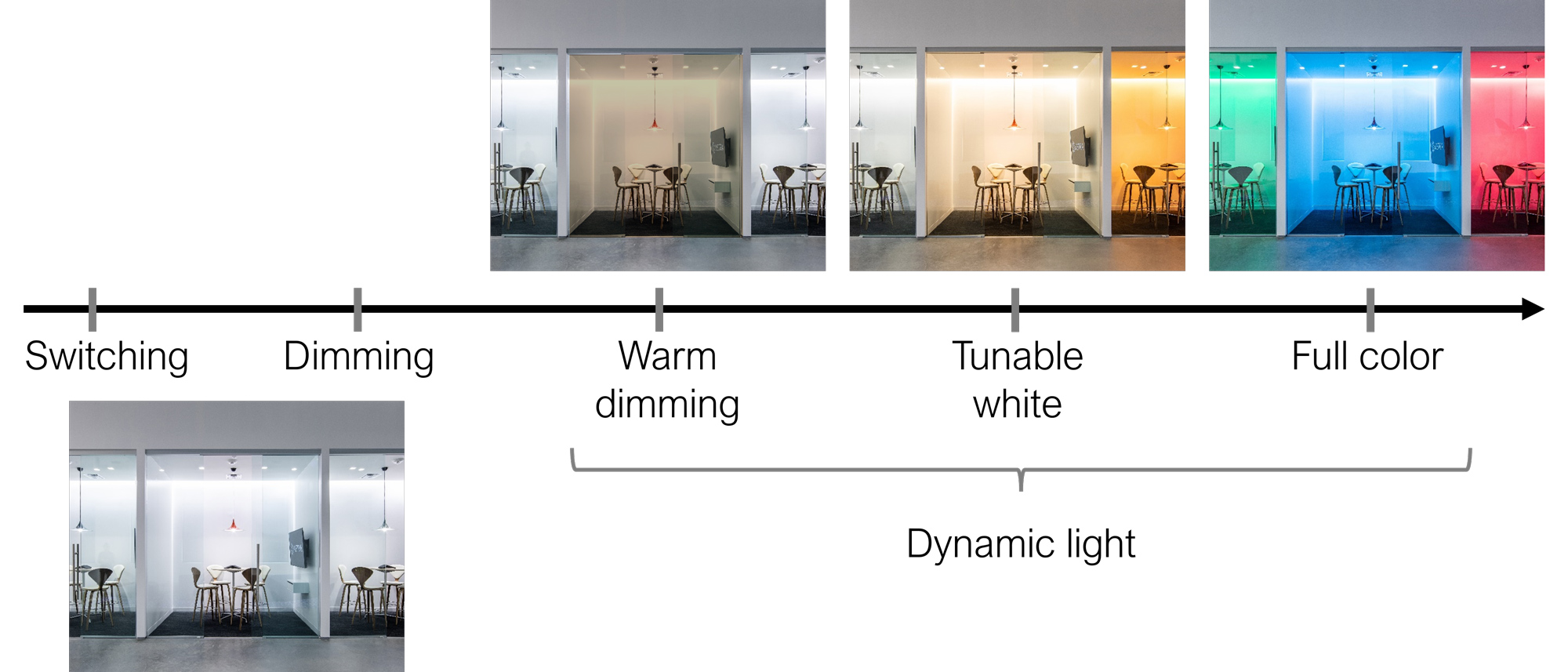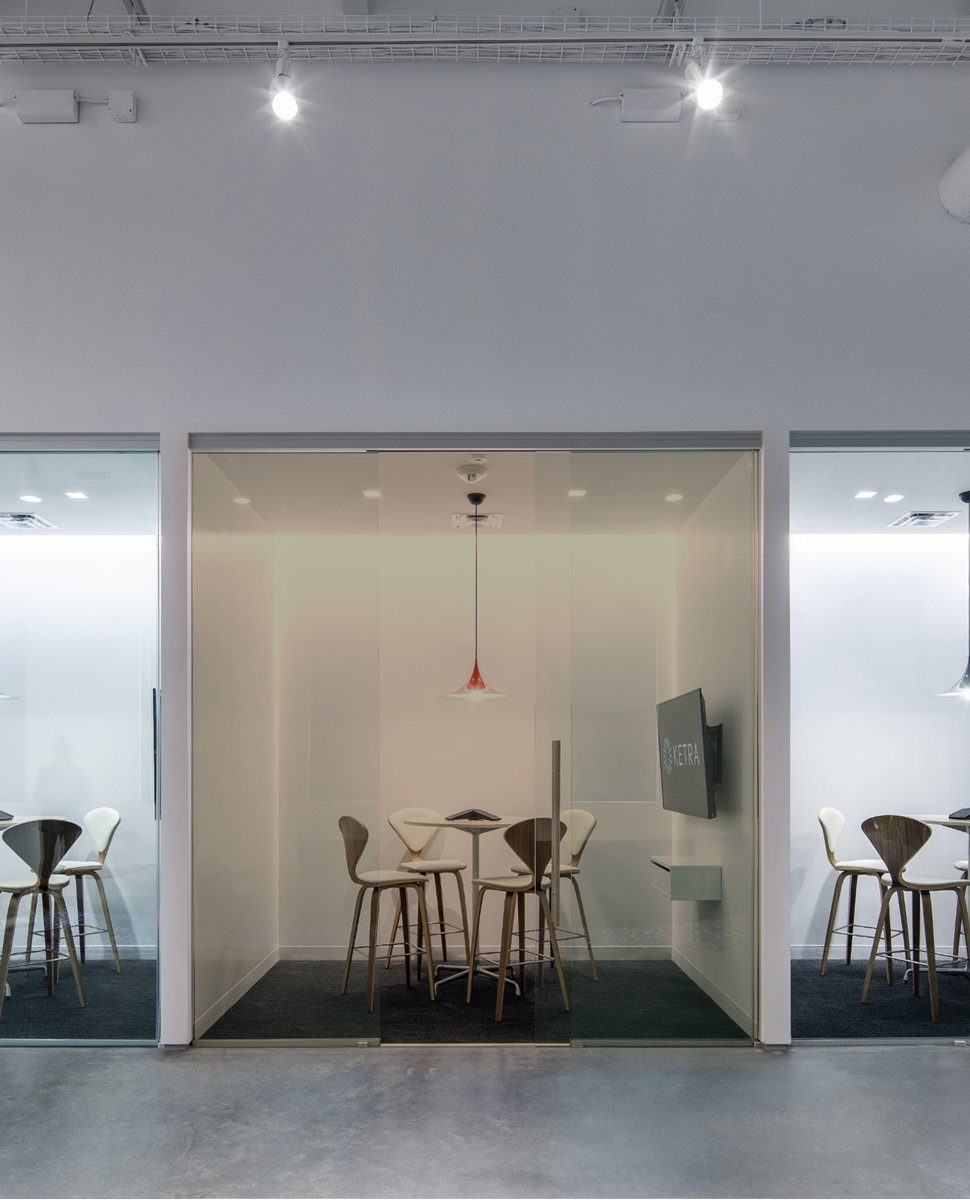Human-Centric Lighting Made Simple with Automation
THE IMPORTANCE OF HUMAN-CENTRIC LIGHTING
Human-centric lighting focuses on the well-being of building occupants in addition to meeting energy-saving goals and standards. Natural daylight provides the dynamic light we all desire, with color and intensity that change subtly throughout the day. Human-centric lighting aims to bring that natural light behavior deeper into the interior.
Also valued are views of the outside, which are highly requested as both a beneficial distraction from computer screens and an increased sense of well-being. In a study, participants with large windows and high vegetation content in their view were found to perform 10 to 25 percent better than those with no view. As was reported in the Harvard Business Review, in a study of 1,600 North American employees, 78 percent mention natural light and views directly impacting their overall happiness and well-being.
However, some aspects of daylight merit consideration when designing for increased daylight and views—glare and solar heat gain. Automated shading, which minimizes glare and rejects thermal heat gain, can benefit these spaces.
Designing for Natural Light
Here are the steps for designing for natural light:
- Daylighting design: Use IES recommended practices. Design to (BS)EN 17037:2019 – Daylighting in Buildings.
- Shading selection: Choose an interior shading solution with proper openness factor and total visible light transmittance.
- Lighting selection: Where daylight penetration into the interior ends, choose a tunable white lighting solution that can mimic natural daylight.
Consider Daylight Autonomy (DA) and Spatial Daylight Autonomy (sDA) to determine the ideal amount of natural light. DA is a metric for understanding how much light arrives at points in a space in relation to how much light is available outside. It allows a designer to compare multiple designs with a single value metric for how well the space is daylit.
Specifying the optimal openness factor and visible light transmission for shade fabric is vital for allowing the right amount of direct daylight into the space. Openness factor affects the direct light transmission, while the visible light transmittance affects both the direct light and diffused light. The higher these figures are, the more daylight enters the space. It is important to remember that this can be at odds with the need for glare control. Proper selection is critical and lighting design professionals can aid in this selection. As noted later in the course, an automated shading system that minimizes the need for user operation creates the most consistent benefits.
Where daylight is lacking, creating electric light that mimics natural light is based on a sophisticated solution known as tunable white, which allows the color temperature to be programmed for optimal natural light mimicry.
LIGHT AND WALL CONTROL
Evolution of the Lighting Control Experience
When lighting control emerged in the modern era, a simple switch achieved the desired function. While mundane by today’s standards, it was revolutionary at the time. Before this, people used candles or gas lamps, which both needed to be lit to operate.
Following switching, dimming became widely possible in the early 1960s. Just as daylight gets dimmer at the end of the day, people could dial down the lights accordingly. In many commercial spaces, dimming and switching rose to new levels. As an example, banks of dimmers controlled the lighting in entire restaurants. A permanent marker line often indicated dimmer settings for specific times, which required a worker to adjust the lights, control by control, throughout the day.
Scene control did away with the need for banks of wallbox dimmers. A single button could control many lighting zones to a predetermined level. Personalized control allows spaces to dynamically change as the occupants’ needs change.
Evolution of the Automated Experience
A timeclock is as simple as it sounds. At a specific time of day, the timeclock causes an event, such as shutting off lights. Timeclocks were instigated by energy codes requiring lights to shut off when the building was typically unoccupied. Eventually, this was applied to exterior lighting to ensure they were shut off during the day.
Another iteration of this is the astronomic time clock, which relates the time to an offset from either sunrise or sunset. In this case, for example, the parking lot lighting may shut off 30 minutes after sunrise.
To further save energy, the energy codes started mandating the use of occupancy and vacancy sensors. An occupancy sensor turns lights on when a space becomes occupied and then shuts them off after the room is continuously unoccupied. A vacancy sensor will not turn lights on but will still shut the lights off once everyone has left the space.
The energy benefit is that instead of having the lighting in the whole building be on or off based on when the entire building is typically occupied or unoccupied, now individual spaces can benefit from shutting off lighting based on the occupancy of each space. Take a bathroom, for instance. These spaces are not necessarily continuously occupied, but lights should turn on when someone enters the space and then shut off after someone exits the space. While this may be a convenience aspect for not interacting with the control, this was still a feature added for energy and not for the occupant.
Automated control ensures enough light when daylight is insufficient but dims the light when there is ample daylight. This human-centric strategy means a person does not have to raise or dim the lights just to keep their target illumination levels on their desk or any other work surface.
Automated shade control is all about minimizing glare and reducing solar heat gain. Both of these ensure the comfort of the individual in the space. Fewer than 10 percent of manual shades are moved more than once per day, so even if a person minimized glare by closing the shades, they are unlikely to benefit from having the shades open for views when the sun is no longer entering the room.
Daylight mimicry is an automation for the electric lighting in the room. Generally, this is a tunable white light source that can change its color temperature based on the time of day to mimic the natural rhythms of the day. This automation was designed for the occupants’ well-being and not for energy savings. Even in an interior room without access to daylight, an occupant can experience the daily change in color temperatures that mimic daylight.
TECHNOLOGY CONSIDERATIONS
Following are the technology considerations for human-centric lighting.
What is Dynamic Light?
Beyond what switching and dimming have provided regarding adjustability in light level, there is also the concept of dynamic light. Today, we can find lamps that provide warm dimming, mimicking the warming effect of incandescent lamps as they dim. Tunable white is a lighting technology that allows for variation in color temperature at any dimming level. Color changing has been around for a long time but has become even easier with LEDs to access a wide array of saturated colors.

Image courtesy of Lutron Electronics Co., Inc.
Dynamic light mimics natural light.
Static White
Static white LEDs maintain a consistent color temperature, providing a stable lighting environment without adjustable features. Although dimmable, static white LEDs compromise on color temperature, limiting their adaptability in dynamic lighting scenarios. Static white LEDs find application in environments with minimal color demand. The primary reasons they are used are cost, control complexity, and availability.

Image courtesy of Lutron Electronics Co., Inc.
Static white LEDs do not have adjustable features.
Warm Dim
Warm dimming means the light source’s color temperature warms as the light dims. It has a similar feel to incandescent light in that its coolest light output comes at high end, and its warmest light output comes at low end. This similarity to incandescent sources is the benefit of pushing the technology, giving people a familiar experience.
One of the concerns of warm dimming is that it is relatively inflexible. Like incandescent, you are locked into a specific CCT for each intensity. You cannot decide if you want a dim, cool, or full warm light.
The other downside is that more philosophical arguments are occurring in the lighting industry. While this technology makes LEDs seem more like incandescent, is that the direction we want to go? LEDs are a powerful tool that can do many different things, so should we lock into this limiting technology to mimic the older technology?

Image courtesy of Lutron Electronics Co., Inc.
Warm dimming has a similar feel to incandescent lighting.
Tunable White
Tunable white technology allows for independent control of intensity and color temperature. In the past, some light sources forced the user to control one warm and one cool intensity and mix them to get the desired brightness and color temperature, which is a complicated process. While some of that persists today, DALI 2 DT8 and other protocols require a single digital address to control both intensity and CCT. As a result of decoupling the two values, the user decides the color temperature and intensity.








